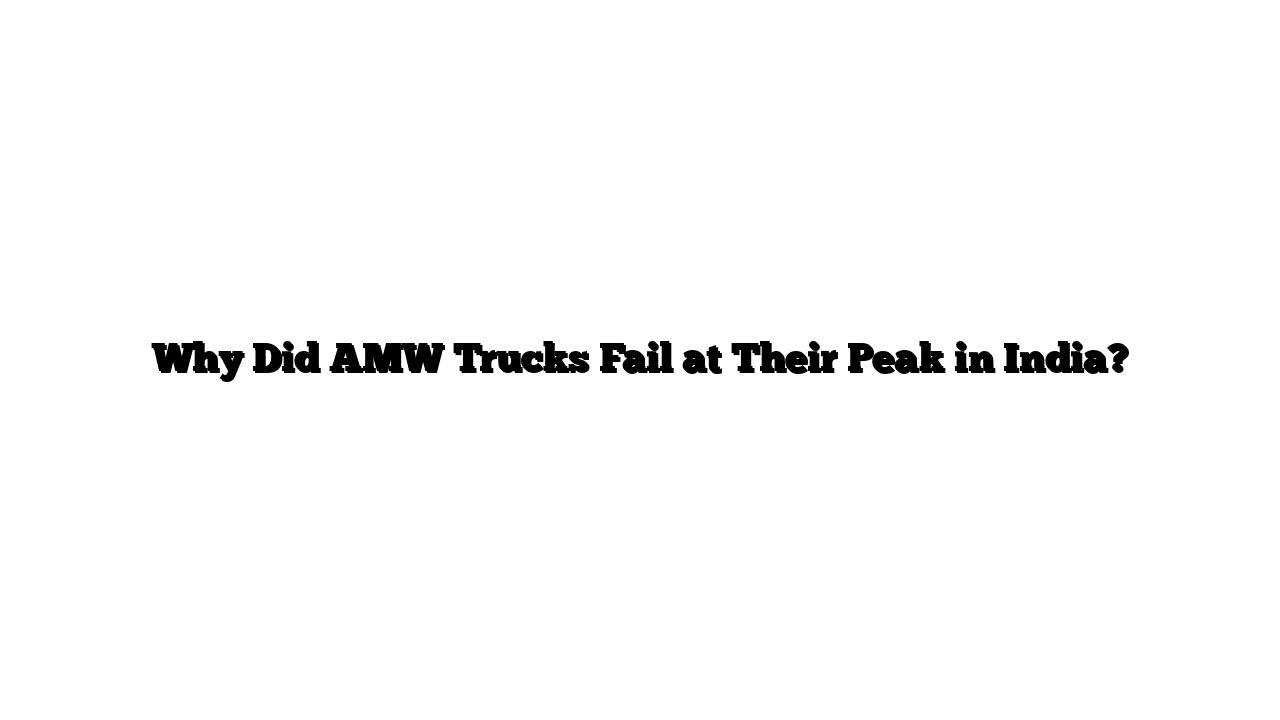AMW (Asia Motor Works) made waves in the Indian commercial vehicle market when it first entered in 2002, offering high-quality trucks at an affordable price. But despite their early success, AMW’s journey ended abruptly, leaving many wondering what went wrong. In this article, we’ll break down the story of AMW’s rise and fall in India, and what led to the untimely shutdown of the company.
AMW’s Bold Entry Into the Indian Market
India’s automotive market is one of the largest in the world, ranking third overall and fourth in the commercial vehicle segment, with major players like Tata Motors and Ashok Leyland dominating the space. But in 2002, AMW entered the scene with a unique approach—they aimed to provide quality, comfortable trucks, unlike the conventional, budget-friendly options already available in the market.
While other companies focused on building affordable trucks, AMW stood out by prioritizing comfort and durability, using high-quality components sourced from global suppliers. This approach quickly caught the attention of customers who were looking for something beyond the basic trucks available at the time.
Rapid Growth: How AMW Became a Market Leader
By 2005, AMW trucks were making a big splash in the market. Their commitment to offering superior features at competitive prices helped them gain significant traction. Within just a few years, the company grew rapidly and became one of the prominent players in India’s commercial vehicle market.
Between 2010 and 2012, AMW had reached an impressive 25% market share in the commercial vehicle segment, a remarkable achievement in such a short span. But what fueled this growth?
The Key to Their Success
AMW was founded by Aniruddh Bohlka, a businessman with experience in heavy equipment, and Shashi Ruheen, one of the founding members of the S. L. Group. Together, they created a business strategy that involved assembling world-class components rather than manufacturing them from scratch. This meant that instead of creating their own parts, AMW sourced high-quality components from established manufacturers around the world.
For example, AMW used Cummins engines, ZF gearboxes, Valeo clutches, Tata axles, and even imported cabs from China’s top cabin manufacturers. By combining these world-class parts, AMW was able to offer trucks that were durable, reliable, and high-performing.
This innovative approach, combined with a strategic location for their factory in Gujarat, gave them an edge in terms of both cost-effectiveness and production efficiency. The location near major ports like Kandla and Mundra helped reduce logistics costs, allowing them to keep their truck prices competitive.
The Rise and Fall of AMW: What Went Wrong?
Despite its initial success, AMW soon faced significant challenges that led to its downfall.
The Financial Strain of Rapid Expansion
AMW’s strategy of rapid expansion and heavy investment started to catch up with them. In 2006, the company made a major decision to acquire 600 acres of land in Gujarat to set up a new plant. While this increased production capacity, it also led to higher debt as the company took loans from banks and investors to finance the project.
The new plant was meant to help AMW enter multiple segments, including light commercial vehicles, medium commercial vehicles, and even buses. However, this massive expansion required ongoing financial backing, and AMW found itself deeply in debt.
The Economic Slowdown and Its Impact
By 2008, an economic slowdown hit India, and the commercial vehicle market took a significant hit. The demand for high-end commercial vehicles dropped by 37% compared to previous years. AMW’s trucks, though high-quality, were positioned in the higher-end market and weren’t immune to the broader market trends.
At the same time, AMW continued to ramp up production and expand despite the slowing demand, increasing their financial burden. The company had failed to cut down on costs or adjust to the changing market conditions, leading to an unsustainable business model.
The Final Blow: Market Collapse and Legal Hurdles
In 2012, the company faced a major setback when the Supreme Court of India banned coal mining in Odisha and Jharkhand, two key markets where AMW had a strong presence. Their tipper trucks, which were widely used in mining operations, suddenly became obsolete in these regions. This hit AMW hard, as these areas accounted for nearly 25% of their total sales.
With the loss of these crucial markets, the company’s financial situation became untenable. Despite the high quality of their trucks and early market success, AMW was unable to recover from this blow.
Lessons from AMW’s Journey
AMW’s rise and fall offer valuable lessons in business management and strategy. Here are the key takeaways:
- Rapid Expansion Can Be Risky: While expanding quickly can bring rewards, it also increases financial risks, especially when not paired with careful market research and flexibility.
- Debt Management Is Critical: Taking on too much debt to finance growth can backfire, especially if market conditions change unexpectedly.
- Adapting to Market Changes: Businesses must be able to pivot quickly when their core markets collapse or when external factors (like legal changes or economic downturns) affect their performance.
- Quality Still Matters: Despite the failure, AMW trucks were known for their durability and comfort, showing that quality can make a huge impact on customer loyalty and brand reputation.
Final Thoughts
AMW’s story is a classic example of how even well-laid plans can fall apart due to unforeseen circumstances and poor financial management. While the company initially thrived by offering high-quality, durable trucks, it couldn’t navigate the financial challenges of rapid expansion and changing market conditions.
For companies today, AMW’s rise and fall highlight the importance of balancing growth with financial stability and the need to remain adaptable in an ever-changing business environment.
